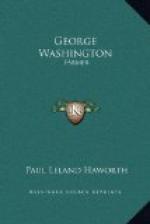The region in which they traveled was then little known and was unsettled by white men. Daniel Boone had made his first hunting trip into “the dark and bloody ground of Kaintuckee” only the year before, and scattered along the banks of the Ohio stood the wigwam villages of the aboriginal lords of the land. At one such village Washington met a chief who had accompanied him on his memorable winter journey in 1753 to warn out the French, and elsewhere talked with Indians who had shot at him in the battle of the Monongahela and now expressed a belief that he must be invulnerable. At the Mingo Town they saw a war party of three score painted Iroquois on their way to fight the far distant Catawbas. Between the Indians and the white men peace nominally reigned, but rumors were flying of impending uprisings, and the Red Man’s smouldering hate was soon to burst into the flame known as Lord Dunmore’s War. Once the party was alarmed by a report that the Indians had killed two white men, but they breathed easier on learning that the sole basis of the story was that a trader had tried to swim his horse across the Ohio and had been drowned. In spite of uncertainties, the voyagers continued to the Great Kanawha and paddled about fourteen miles up that stream. Near its mouth Washington located two large tracts for himself and military comrades and after interesting hunting experiences and inspecting some enormous sycamores—concerning which matters more hereafter—the party turned back, and Washington reached home after an absence of nine weeks.
Two of Washington’s western tracts are of special interest. One had been selected by Crawford in 1767 and was “a fine piece of land on a stream called Chartiers Creek” in the present Washington County, southwest of Pittsburgh. Crawford surveyed the tract and marked it by blazed trees, built four cabins and cleared a patch of ground, as an improvement, about each. Later Washington, casting round for some one from whom to obtain a military title with which to cover the tract, bought out the claim of his financially embarrassed old neighbor Captain John Posey to three thousand acres, paying L11.11.3, or about two cents per acre. Crawford, now a deputy surveyor of the region, soon after resurveyed two thousand eight hundred thirteen acres and forwarded the “return” to Washington, with the result that in 1774 Governor Dunmore of Virginia granted a patent for the land.
In the meantime, however, six squatters built a cabin upon the tract and cleared two or three acres, but Crawford paid them five pounds for their improvements and induced them to move on. To keep off other interlopers he placed a man on the land, but in 1773 a party of rambunctious Scotch-Irishmen appeared on the scene, drove the keeper away, built a cabin so close in front of his door that he could not get back in, and continued to hold the land until after the Revolution.
By that time Crawford himself was dead—having suffered the most terrible of all deaths—that of an Indian captive burnt at the stake.




